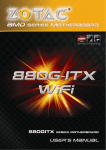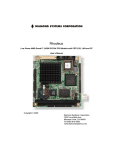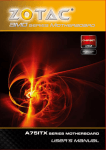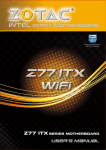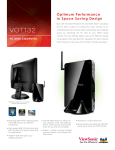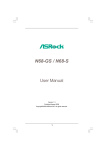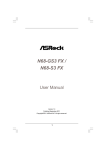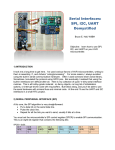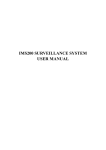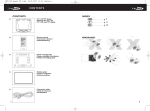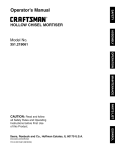Download Zotac IONITX-F-E motherboard
Transcript
WARNING! Electronic Emission Notices Federal Communications Commission (FCC) Statement This equipment has been tested and found to comply with the limits for a Class B digital device, pursuant to Part 15 of FCC Rules. These limits are designed to provide reasonable protection against harmful interference in a residential installation. This equipment generates, uses and can radiate radio frequency energy and, if not installed and used in accordance with instructions contained in this manual, may cause harmful interference to radio and television communications. However, there is no guarantee that interference will not occur in a particular installation. If this equipment does cause harmful interference to radio or television reception, which can be determined by turning the equipment off and on, the user is encouraged to try to correct the interference by one or more of the following measures: - - - - REORIENT OR RELOCATE THE RECEIVING ANTENNA INCREASE THE SEPARATION BETWEEN THE EQUIPMENT AND THE RECEIVER CONNECT THE EQUIPMENT INTO AN OUTLET ON A CIRCUIT DIFFERENT FROM THAT OF THE RECEIVER CONSULT THE DEALER OR AN EXPERIENCED AUDIO/TELEVISION TECHNICIAN NOTE: Connecting this device to peripheral devices that do not comply with Class B requirements, or using an unshielded peripheral data cable, could also result in harmful interference to radio or television reception. The user is cautioned that any changes or modifications not expressly approved by the party responsible for compliance could void the user’s authority to operate this equipment. To ensure that the use of this product does not contribute to interference, it is necessary to use shielded I/O cables. Copyright This manual is copyrighted with all rights reserved. No portion of this manual may be copied or reproduced by any means. While every precaution has been taken in the preparation of this manual, no responsibility for errors or omissions is assumed. Neither is any liability assumed for damages resulting from the use of the information contained herein. Trademarks All brand names, logos and registered trademarks mentioned are property of their respective owners. NVIDIA ION PCIEx16 series Motherboard Table of Contents Motherboard Specifications-------------------------------------------------------------------- 4 Motherboard Layout------------------------------------------------------------------------------ 6 Hardware Installation----------------------------------------------------------------------------- 9 Safety Instructions------------------------------------------------------------------------------ 9 Preparing the Motherboard--------------------------------------------------------------------- 10 Installing Memory DIMMs--------------------------------------------------------------------- 10 Installing the Motherboard-------------------------------------------------------------------- 11 Installing the I/O Shield------------------------------------------------------------------------ 11 Connecting Cables and Setting Switches------------------------------------------------- 12 20-pin ATX Power-PW1----------------------------------------------------------------------- 13 Front Audio Header-FP_S1------------------------------------------------------------------- 13 serial Port Header - COM--------------------------------------------------------------------- 14 SPK Header-------------------------------------------------------------------------------------- 14 USB Headers------------------------------------------------------------------------------------ 14 SPDIF-out Header------------------------------------------------------------------------------ 15 Front Panel Header----------------------------------------------------------------------------- 15 Connecting Serial ATA Cables--------------------------------------------------------------- 16 Fan Connections-------------------------------------------------------------------------------- 16 Expansion Slots--------------------------------------------------------------------------------- 17 Mini PCIE Slot------------------------------------------------------------------------------- 17 PCI Express x16 slots--------------------------------------------------------------------- 17 Jumper Settings--------------------------------------------------------------------------------- 18 Configuring the BIOS----------------------------------------------------------------------------- 19 Enter BIOS Setup------------------------------------------------------------------------------------ 19 Main Menu--------------------------------------------------------------------------------------- 20 Advanced Menu-------------------------------------------------------------------------------- 20 CPU Configuration-------------------------------------------------------------------------- 20 IDE Configuration--------------------------------------------------------------------------- 21 Floppy Configuration----------------------------------------------------------------------- 21 ACPI Configuration------------------------------------------------------------------------- 21 APM Configuration-------------------------------------------------------------------------- 21 Event Log Configuration------------------------------------------------------------------ 21 MPS Configuration------------------------------------------------------------------------- 21 PCI Express Configuration--------------------------------------------------------------- 21 Smbios Configuration---------------------------------------------------------------------- 21 USB Configuration-------------------------------------------------------------------------- 21 PCI/PnP Menu---------------------------------------------------------------------------------- 22 Boot Menu--------------------------------------------------------------------------------------- 23 Security Menu---------------------------------------------------------------------------------- 24 Chipset Menu----------------------------------------------------------------------------------- 25 Table of Contents Exit Menu---------------------------------------------------------------------------------------- 25 Installing Drivers and Software--------------------------------------------------------------- 27 Drivers Installation - ------------------------------------------------------------------------------ 28 HDMI SETUP ---------------------------------------------------------------------------------------- 35 REALTEK HD AUDIO DRIVER SETUP ------------------------------------------------------ 36 Getting Started----------------------------------------------------------------------------------- 36 Sound Effect-------------------------------------------------------------------------------------- 36 Environment Simulation----------------------------------------------------------------------- 36 Equalizer Selection ---------------------------------------------------------------------------- 37 Frequently Used Equalizer Setting--------------------------------------------------------- 37 Karaoke Mode----------------------------------------------------------------------------------- 37 Mixer----------------------------------------------------------------------------------------------- 38 Playback control---------------------------------------------------------------------------- 38 Recording control--------------------------------------------------------------------------- 39 Audio I/O-------------------------------------------------------------------------------------- 40 Speaker Configuration-------------------------------------------------------------------- 41 Connector Settings------------------------------------------------------------------------- 42 S/PDIF ---------------------------------------------------------------------------------------- 42 Speaker Calibration------------------------------------------------------------------------ 43 Microphone---------------------------------------------------------------------------------- 44 Noise Suppression------------------------------------------------------------------------- 44 Beam Forming------------------------------------------------------------------------------ 44 Acoustic Echo Cancellation-------------------------------------------------------------- 44 Audio Demo---------------------------------------------------------------------------------- 45 Information ---------------------------------------------------------------------------------- 45 SATA RAID User Manual------------------------------------------------------------------------- 46 Setting up the BIOS---------------------------------------------------------------------------- 46 Entering the RAID BIOS Setup-------------------------------------------------------------- 47 Installing the RAID Drives--------------------------------------------------------------------- 50 NVIDIA ION PCIEx16 series Motherboard Motherboard Specifications q C hipset v NVIDIA MCP7A-ION Series q Size v Mini-ITX form factor of 6.69inch x 6.69 inch(171mm x 171mm) qMicroprocessor support v Intel ATOM 230 / 330 CPU v Support for 533 MT/s(533MHz FSB) qOperating systems: v Supports Windows XP 32bit/64bit and Windows Vista 32bit/64bit qSystem Memory support v Supports DDRII667/800. Supports up to 4GBs DDRII memory. v Supports dual Channel DDR2 128-Bit Memory Interface qUSB 2.0 Ports v Supports hot plug and play v Ten USB 2.0 ports (six rear panel ports, four from onboard USB headers) v Supports USB 2.0 protocol up to 480 Mbps transmission rate qOnboard Serial ATA II v Independent DMA operation on four ports (three is onboard SATA headers, one is rear panel e-SATA). v Data transfer rates of 3Gb/s. q On board RTL8211CL Gigabit LAN(Optional) v Supports 10/100/1000M bps operation q On board RTL8201EL Fast Ethernet(Optional) v Supports 10/100Mbps operation v Supports half/full duplex operation qOnboard Audio(Optional) v Azalia High-Definition audio v Supports 6-channel v Supports Jack-Sensing function qGreen Function v Supports ACPI (Advanced Configuration and Power Interface) v RTC timer to power-on the system v AC power failure recovery q PCI Express Interface v PCI Express Generation 2.0 compatible v 5 GHz support, for a total bandwidth of 5 Gbps per direction per lane v Wake up function is supported v Clock spread spectrum capability. Motherboard Specifications qOnboard Graphics support v Integrated 300MHz DAC for analog displays with resolutions up to 1920x1440 at 75Hz. v Integrated GeForce 9xxx Series GPU,Supports DX10 v VGA / DVI / HDMI output support(optional) q Integrated HDMI Interface with HDCP v Supports DVI or HDMI 1.3 interfaces v Secure digital audio merged from integrated HDA codec with no external audio signals required v Support for HDCP 1.3 using soft or hard HDCP keys v HDCP encryption support when configured as DVI or HDMI link without the need for external HDCP key crypto ROM q Dual Head Display Controller v Full NVIDIA nView™ multi-display technology capability, with independent display controllers for the CRT, TMDS, DisplayPort, and HDMI interface v Each controller can drive same or different display contents to different resolutions and refresh rates q Expansion Slots v One Mini PCI Express slot.(Occupied by WiFi module in some models) v One PCI Express x16 slot NVIDIA ION PCIEx16 series Motherboard Motherboard Layout Figure 1 shows the motherboard and Figure 2 shows the back panel connectors. 14 15 1617 � C_FAN1 JP3 b K d Keyboard /USB 121 121 � SPDIF-OUT � DDRII2 DDRII1 CPU HDMI DVI/VGA 13 18 19 Chiset USB-FP_U2 USB-FP_U1 20 pin ATX Power-PW1 + eSATA/USB CHIP_FAN- J2505 1 Lithium cell CR2032 3V SC7 120 240 120 240 S_FAN1 COM Mini PCIE SD1 FP1 52 51 PT3 1 2 Front Audio -FP_S1 1 1 LAN/USB Clear CMOS - JP1 1 SATA1 SATA2 SATA3 PCIE1 SPK1 SPDIF 12 11 10 9 Figure 1. 8 76 54 Board Layout 1. 20-pin ATX Power Connector 11. Chip Fan Connector 2. System Fan Connector 12. Front Audio Header 3. Front Panel Header 13. Backpanel Connectors 4. Speaker Header 14. USB power Jumper(PCB Ver:01) 5. SPDIF-out Header 15. USB Headers 6. COM Header 16. CPU 7. Serial-ATA (SATA) Connectors 17. Chipset 8. PCI Express x16 18. CPU Fan Connector 9. Clear CMOS Jumper 19. DDRII DIMM Sockets 10. Mini PCIE Slot 2 3 Rear Panel Figure 2: Backpanel connectors 9 5 10 15 2 3 4 10 8 6 11 5 6 2 7 1.PS/2 keyboard connector 2.USB Connectors 3. HDMI Port 4. S PDIF Out(Coaxial / Optical) 5. DVI Connector 6. eSATA Connector 7.Port Blue Green Pink 2-Channel Line-In Line-Out Mic In 4-Channel Rear Speaker Out Front Speaker Out Mic In 6-Channel Rear Speaker Out Front Speaker Out Center/Subwoofer 8. LAN Connector Lan Port with LEDs to indicate status. · Yellow/Light Up/Blink = 10 Mbps/Link/Activity · Yellow and Orange/Light Up/Blink = 100 Mbps/link/Activity · Yellow and Orange/Light Up/Blink = 1000 Mbps/link/Activity 9. VGA Port NVIDIA ION PCIEx16 series Motherboard 10. WiFi antenna connctor(Optional) Remove the red antenna connector cover(as picture 1), install the antenna to the connector and make sure that screw down clockwise(as picture 2),at last as picture 3. 4 510 15 6 11 121 � 5 121 � CPU � 510 15 + 6 11 Lithium cell CR2032 3V SC7 240 120 240 According to your requirement modulate to the antenna as right picture. 120 236-DA123-xx01F * How to ����������������������� identify������������ PCB Version The bottom side of motherboard PCB shows “236-DA123-xx01F” Motherboard PCB Version:01 Note: * Different motherboard PCB version could carry slightly different features and components placement . Please refer to the following diagram to identify PCB version: 6 Hardware Installation Hardware Installation This section will guide you through the installation of the motherboard. The topics covered in this section are: qPreparing the motherboard v Installing the memory q Installing the motherboard qConnecting cables and setting switches Safety Instructions To reduce the risk of fire, electric shock, and injury, always follow basic safety precations. Remember to remove power from your computer by disconnecting the AC main source before removing or installing any equipment from/to the computer chassis NVIDIA ION PCIEx16 series Motherboard Preparing the Motherboard The motherboard shipped in the box does not contain a memory. You need to purchase these to complete this installation. Installing Memory DIMMs Your new motherboard has two 1.8V 240-pin slots for DDR2 memory. These slots support 256 MB, 512 Mb, 1GB / 2GB / 4GB DDR2 technologies. There must be at least one memory bank populated to ensure normal operation. Use the following the recommendations for installing memory. (See Figure 1 for the location of the memory slots.) qOne DIMM: You can install the DIMM into any slot. qTwo DIMMs: Install into slots 1 and 2. The idea is to run on dual channel mode. � CPU + � � Lithium cell CR2032 3V S C7 120 121 240 120 121 240 10 DDRII-1 DDRII-2 Hardware Installation Use the following procedure to install memory DIMMs into the slots on the motherboard. Note that there is only one gap near the center of the DIMM slot. This slot matches the slot on the memory DIMM to ensure the component is installed properly. 1.Unlock a DIMM slot by pressing the module clips outward. 2.Align the memory module to the DIMM slot, and insert the module vertically into the DIMM slot. The plastic clips at both sides of the DIMM slot automatically lock the DIMM into the connector. Installing the Motherboard The sequence of installing the motherboard into the chassis depends on the chassis you are using and if you are replacing an existing motherboard or working with an empty chassis. Determine if it would be easier to make all the connections prior to this step or to secure the motherboard and then make all the connections. It is normally easier to secure the motherboard first. Use the following procedure to install the I/O shield and secure the motherboard into the chassis. Installing the I/O Shield The motherboard kit comes with an I/O shield that is used to block radio frequency transmissions, protects internal components from dust and foreign objects, and promotes correct airflow within the chassis. Before installing the motherboard, install the I/O shield from the inside of the chassis. Press the I/O shield into place and make sure it fits securely. If the I/O shield does not fit into the chassis, you would need to obtain the proper size from the chassis supplier. 11 NVIDIA ION PCIEx16 series Motherboard Connecting Cables and Setting Switches This section takes you through all the connections and switch settings necessary on the motherboard. This will include: qPower Connections v 20-pin ATX power-PW1 v Front Audio Header-FP_S1 q Internal Headers v Serial Port Header - COM v SPK Header v USB Headers v SPDIF-out Headers v Front panel header q Serial ATA qChassis Fans qMini PCIE Connector qJumper settings See Figure 1 to locate the connectors and jumpers referenced in the following procedure. 12 Hardware Installation 20-pin ATX Power-PW1 PW1 is the main power supply connector located along the edge of the board next to the DIMM slots. Make sure that the power supply cable and pins are properly aligned with the connector on the motherboard. Firmly plug the power supply cable into the 20 PW1 11 connector and make sure it is secure. ATXPWR-Pin Assignments Signal Pin Signal 1 +3.3V 11 +3.3V 2 +3.3V 12 -12V 3 GND 13 GND 4 +5V 14 PS_ON 5 GND 15 GND 6 +5V 16 GND 7 GND 17 GND 8 PWROK 18 -5V 9 +5V_AUX 19 +5V 10 +12V 20 +5V 10 1 Lithium cell CR2032 3V SC7 120 240 121 120 240 121 Pin � + CPU � � Front Audio Header-FP_S1 The audio connector supports HD audio standard and provides two kinds of audio output choices: the Front Audio, the Rear Audio. The front Audio supports re-tasking function. FP Audio-Pin Definition Assignment 6 Reserved 2 GND 7 FAVDIO-JD 3 MIC(R) 8 Key(No pin) 4 -ACZ-DET 9 Front Audio(L) 5 Front Audio(R) 10 Reserved FP_S1 PIN MIC2(L) 9 Assignment 1 10 PIN 1 2 Note: In order to utilize the front audio header, your chassis must have front audio connector. Also please make sure the pin assignment on the cable is the same as the pin assignment on the mainboard header. To find out if the chassis you are buying supports a front audio connector, please contract your dealer. 13 NVIDIA ION PCIEx16 series Motherboard Serial Port Header - COM COM-Pin Definition PIN Assignment PIN Assignment 1 DCD 6 DSR 2 RXD 7 RTS 3 TXD 8 CTS 4 DTR 9 RI 5 GND 10 NC COM 2 1 10 9 SPK Header SPK-Pin Definition VCC 2 NC � CPU Assignment 1 + PIN NC 4 SPK- � Lithium cell CR2032 3V SC7 3 � 120 121 240 SPK 120 121 240 1 10 9 FP_U2 2 1 14 10 9 FP_U1 This motherboard contains six USB 2.0 ports that are exposed on the rear panel of the chassis(Figure 2). The motherboard also contains six 10-pin internal header connectors onboard. 1.Secure the bracket to either the front or rear panel of your chassis (not all chassis are equipped with the front panel option). 2 1 USB Headers USB-Pin Definition PIN Assignment PIN Assignment 1 VCC 6 USBP1+ 2 VCC 7 GND 3 USBP0- 8 GND 4 USBP1- 9 KEY 5 USBP0+ 10 OC# Hardware Installation SPDIF-out Header SPDIF-Pin Definition GND 2 SPDIF-out 3 VCC � CPU Assignment 1 + PIN � � Lithium cell CR2032 3V SC7 120 SPDIF 121 240 120 121 240 1 Front panel header The front panel header on this motherboard is one connector used to connect the following four cables : FP1-Pin Definition Pin Signal Pin Signal 1 HDD_LED+ 6 PWR_SW 2 PW_LED+ 7 RESET 3 HDD_LED- 8 GND 4 PW_LED- 9 NC 5 GND 10 KEY FP1 2 1 10 9 q P WRLED Attach the front panel power LED cable to these two pins of the connector. The Power LED indicates the system’s status. q PWR SW Attach the power button cable from the case to these two pins. Pressing the power button on the front panel turns the system on and off rather than using the power supply button. q HDD LED Attach the hard disk drive indicator LED cable to these two pins. The HDD indicator LED indicates the activity status of the hard disks. qRST SW Attach the Reset switch cable from the front panel of the case to these two pins. The system restarts when the RESET switch is pressed. Note:Some chassis do not have all four cables. Be sure to match the name on the connectors to the corresponding pins. 15 NVIDIA ION PCIEx16 series Motherboard Connecting Serial ATA II Cables The Serial ATA II connector is used to connect the Serial ATA II device to the motherboard. These connectors support the thin Serial ATA II cables for primary storage devices. The current Serial ATA II interface allows up to 3Gb/s data transfer rate. There are three serial ATA II connectors on the motherboard that support AHCI and RAID configurations. SATA II Pin Definition PIN SIGNAL 1 SATA -1 1 SATA -2 1 SATA -3 � CPU GND TXP TXN GND RXN RXP GND + 1 2 3 4 5 6 7 120 121 240 120 121 240 There are three fan connections on the motherboard. The fan speed can be detected and viewed in the PC Health Status section of the CMOS Setup. If your system working at a torrid room,you can append a FAN to the heatsink.Connect the FAN cable(as picture 11) to SYS fan connector(as picture 10) and fixup the FAN on the heatsink with screw(as picture 12). SYS FAN Connector CPU FAN Connector GND +12V Sense Control Sense +12V CHIP FAN Connector GND 5V GND 16 120 240 12 120 � 121 121 CPU � � � + Lithium cell CR2032 3V SC7 11 121 CPU � � 121 note: Fan is only for 330 CPU board! 10 � Lithium cell CR2032 3V SC7 Fan Connections � + 240 Lithium cell CR2032 3V SC7 120 240 120 240 Hardware Installation Expansion slots The NVIDIA MCP7a motherboard provide one expansion slot. � 121 121 � � CPU + 2 1 Mini PCIE Lithium cell CR2032 3V SC7 120 240 120 240 52 51 PCI Express x16 slot Mini PCIE slot There is one Mini PCI Express slot,reserved for WiFi Module. PCI Express x16 slots There is one PCI Express x16 slot reserved for graphics or video cards. The bandwidth of the x16 slot is up to 4GB/Sec complianting with PCIE 1.1 specification. When installing a PCI Express x16 card, be sure the retention clip snaps and locks the card into place. If the card is not seated properly, it could cause a short across the pins. Secure the card’s metal bracket to the chassis back panel with the screw used to hold the blank cover. 17 NVIDIA ION PCIEx16 series Motherboard Jumper Settings This chapter explains how to configure the motherboard’s hardware. Before using your computer, make sure all jumpers and DRAM modules are set correctly. Refer to this chapter whenever in doubt. JP1-CMOS Clear Jumper JP1 Selection 1 1-2* Normal* 1 2-3 CMOS Clear JP3-USB power Jumper(it is only for Ver:01 PCB)* JP3 Selection 1 1-2* 5Vdual * 1 2-3 5V Close Open * = Default setting. If you want to clear the system configuration, use the JP1 (Clear CMOS Jumper) to clear data. Notice: 1. Be sure to save the CMOS setting when exit the CMOS. 2. If the CPU is frequency multiplier locked, no CPU speed change will be seen even if the frequency multiplier setting in CMOS setup is changed. 18 Configuring the BIOS Configuring the BIOS This section discusses how to change the system settings through the BIOS Setup menus. Detailed descriptions of the BIOS parameters are also provided. Enter BIOS Setup The BIOS is the communication bridge between hardware and software. Correctly setting the BIOS parameters is critical to maintain optimal system performance. Use the following procedure to verify/change BIOS settings. 1. Power on the computer., 2. Press the Del key when the following message briefly displays at the bottom of the screen during the Power On Self Test (POST). Pressing Del takes you to the BIOS Setup Utility. Note: It is strongly recommended that you do not change the default BIOS settings. Changing some settings could damage your computer. 19 NVIDIA ION PCIEx16 series Motherboard Main Menu This menu gives you an overview of the general system specifications. The BIOS automatically detects the items in this menu. Note: Note that the data in gray is non-changeable, and the others are for selection. q q q q AMI BIOS Displays the auto-detected BIOS information Processor Display the auto-detected CPU specification System Memory Displays the auto-detected system memory System time Allows you to set the system time Advanced Menu The Advanced menu items allow you to change the setting for the CPU and other system devices.Press <enter> to display the configuration options: CPU Configuration The items in this menu show the CPU-related information that the BIOS automatically detects. Press <enter>to display the configuration options: q Configure advanced CPU settings Displays the auto-detected CPU information 20 Configuring the BIOS q Max CPUID Value Limit Allows you to determine whether to limit CPUID maximum value. Set this item to [Disable] Windows XP operating system; set this item to [Enable] for legacy operating system such as Windows NT4.0.. q Execute Disable Bit Capability This function enhances protection of your computer , reducing exposure to viruses and malicious buffer overflow attacks when working with its supporting software and system. q Hyper Threading Technology Enabled this function for Windows and Linux4 OS, (OS support Hyper Threading Technology) Disabled this function for other OS.(OS not optimized for Hyper Threading Technology) IDE Configuration The items in this menu allow you to set or change the configurations for the IDE devices installed in the system. Press <enter>to display the configuration options: q On-chip SATA Controller This item allow you to enabled or disabled the SATA controller. q SATA Mode select This item allow you to set the SATA to IDE/AHCI/RAID mode. q Hard Disk Write Protect This will be effective only if device is accessed through BIOS. q IDE Detect Time Out The items allow you to select the time out value for detecting ATA/ATAPI devices. q ATA(PI) 80pin cable detection The items allow you to select the mechanism for detecting 80pin ATA(PI) cable. Floppy Configuration The items in this menu allow you to set or change the configurations for the floppy devices installed in the system. ACPI Configuration The items in this menu allow you to setting general APCI configuration. APM Configuration These items allow you to configure Advanced Power Management. Event Log Configuration Make as read,clear,or view Event log statistics. MPS Configuration The items in this menu allow you to configure MPS. PCI Express Configuration The items in this menu allow you to enable or disable PCI Express L0S and L1 link power states. Smbios Configuration SMBIOS SMI wrapper support for PnP Function 50h-54h. USB Configuration The items in this menu allow you to change the USB-related features .Press <enter> To display the configuration options: q Legacy USB Support Allows you to enable or disable support for USB devices on legacy operating systems. q USB 2.0 Controller Mode Allows you to configure the USB 2.0 controller in HiSpeed or Full Speed . 21 NVIDIA ION PCIEx16 series Motherboard q BIOS EHCI Hand-Off Allows you to enable support for operating systems without an EHCI hand-off feature. PCI/PnP Menu The PCI PnP menu items allow you to change the advanced settings for PCI/PnP devices. The menu includes setting IRQ and DMA channel resources for either PCI/ PnP or legacy ISA devices , and setting the memory size block for legacy ISA devices. Press <enter> To display the configuration options: q Clear NVRAM The items allow you to select whether clear NVRAM during system boot. q Plug and Play O/S When set to [No], BIOS configure all the devices in the system. When set to [YES] and if you install a Plug and Play operating system, the operating system configures the Plug and Play devices not required for boot. q PCI Latency Timer Allows you to select the value in units of PCI clocks for PCI device latency timer register. q Allocate IRQ to PCI VGA When set to [YES], BIOS assigns an IRQ to PCI VGA card if the requests for an IRQ. When set to [No], BIOS does not assign an IRQ to the PCI VGA card even if requested . q Palette Snooping When set to [enable], the pallete snooping feature informs the PCI devices that an ISA graphics device is installed in the system so that the latter can function correctly. q PCI IDE BusMaster When set to [enable], BIOS use PCI busmastering for reading /writing to IDE drives. q OffBoard PCI/ISA IDE Card Use this option to set the PCI slot number for some PCI IDE Cards holding. q IRQ-xx assigned to When set to [PCI Device], the specific IRQ is free for use of PCI/PnP devices. When set to [Reserved], the IRQ is reserved for legacy ISA devices. 22 Configuring the BIOS Boot Menu The Boot menu items allow you to change the system boot options .Press <enter> to display the configuration options: Boot settings configuration The items allow you to configure Boot settings . Press <enter> To display the configuration options: q Quick Boot Enabling this item allows the BIOS to skip some power on self tests while booting to decrease the time needed to boot the system. When set to [Disabled], BIOS performs all the POST items. q Quiet Boot When set to [Disabled], displays normal POST message. When set to [Enabled], displays OEM Logo instead of POST messages. q Add On ROM Display Mode Sets the display mode for option ROM. q Bootup Num-Lock Allows you to select the power-on state for the NumLock. q PS/2 Mouse Support Allows you to enable or disable support for PS/2 mouse. q Wait for ‘F1’ If Error When set to [Enabled], the system waits for the F1 key to be pressed when error occurs. q Hit ‘DEL’ Message Display When set to [Enabled], the system displays the message “press DELL to run setup” during POST. q Interrupt 19 Capture When set to [Enabled], this function allows the option ROMS to trap interrupt 19. Boot Device Priority The items allow you to specify the boot device priority sequence. Hard Disk Drivers This option allows you to specify the boot device from hard disk drivers. CD/DVD Drivers This option allows you to specify the boot device from CD/DVD drivers. 23 NVIDIA ION PCIEx16 series Motherboard Security Menu The security menu items allow you to change the system security settings. Press <enter> to display the configuration options: Change Supervisor/User Password Select this item to set or change the supervisor/user password. The Supervisor/user Password item on top of the screen shows the default not installed. After you set a password , this item shows installed. To set a Supervisor/user Password: 1. Select the change supervisor/user password item and press <Enter>. 2. From the password box, type a password compose of at least six letters and/or number, the press <Enter>. 3. Confirm the password when prompted: The message “Password installed” appears after you successfully set your password. To change the supervisor/user password, follow the same steps as in setting a use password. To clear the supervisor/user password, select the change supervisor/user password then press <enter>. The message “password uninstalled” appears. Boot Sector Virus Protection The items allow you to enable or disable booting sector virus protection. 24 Configuring the BIOS Chipset Menu The chipset menu items allow you to change the advanced chipset settings. Press <enter> to display the sub-menu: CPU Bridge Configuration This option allows you to configure CPU bridge chipset configuration, include CSI links speed, CSI Frequency, Memory Frequency, and so on. North bridge configuration The items allow you to configure north bridge features, include Memory, Graphic, Video, and so on. South bridge configuration The items allow you to configure south bridge features, include USB, HAD, PCIE Port, Onboard Lan/1394, CPU GTL REF, and so on. Exit Menu The exit menu items allow you to load the option or failsafe default values for the BIOS items, and save or discard your changes to the BIOS items. Press <enter> to display the sub-menu: 25 NVIDIA ION PCIEx16 series Motherboard Save Change and Exit Once you are finished making your selections, choose this option from the Exit menu to ensure the values you selected are saved to the CMOS RAM. An onboard backup battery sustains the CMOS RAM so it stays on even when the PC is turned off. When you select this option, a confirmation window appears .Select OK to save change and exit. Discard Changes and Exit Select this option only if you do not want to save the changes that you made to the setup program. If you made changes to fields other than system date, system time, and password, the BIOS asks for a confirmation before exiting. Discard Changes This option allows you to discard the selections you made and restore the previously saved values. After selecting this option, a confirmation appears. Select Ok to discard any change and load the previously saved values. Load Optimal Defaults This option allows you to load the default values for each of the parameters on the setup menus. When you select this option, a confirmation window appears. Select Ok to load default values. Select Exit and Save Change or make other changes before saving the values to the non-volatile RAM. Load Failsafe Defaults This option has been set by the manufacturer and represents settings which provide the minimum requirements for your sys to operate. 26 Installing Drivers and Software Installing Drivers and Software Note: It is important to remember that before installing the driver CD that is shipped in the kit, you need to load your operating system. The motherboard supports Windows XP 32bit and 64bit and is Vista-capable. The kit comes with a CD that contains utility drivers and additional software. The CD that has been shipped with your NVIDIA MCP7A motherboard contains the following software and drivers: q Nvidia chipset driver q HDA Sound driver q Nvidia HDMI Audio driver q Wireless Install driver 27 NVIDIA ION PCIEx16 series Motherboard Drivers Installation 1. Insert the driver CD after loading your operating system. Waiting for one minute you can see below interface. 2. Follow the below steps to install Nvidia chipset driver. 28 Installing Drivers and Software 29 NVIDIA ION PCIEx16 series Motherboard 30 Installing Drivers and Software 3. Follow the below for HDA sound driver installing. 31 NVIDIA ION PCIEx16 series Motherboard 4. Follow the below for Nvidia HDMI Audio driver installing. 32 Installing Drivers and Software 5. Follow the below for Wireless LAN driver installing. 33 NVIDIA ION PCIEx16 series Motherboard At last, you can open below page that provides information about the hardware devices on this motherboard, and check whether finish your installation. 34 Installing Drivers and Software HDMI SETUP 1. You can connect HDMI device to the HDMI port directly, or connect to DVI port by a DVI - HDMI dongle. 2. Enter Control Panel, double click “Sounds and Auddio Devices”, select “NVIDIA HDMI Audio” as default play back device, then click ok. 35 NVIDIA ION PCIEx16 series Motherboard Realtek HD Audio Driver Setup Getting Started After Realtek HD Audio Driver being installed (insert the driverCD and follow the onscreen instructions), “Realtek HD Audio Manager” icon will show in System tray as below. Double click the icon and the control panel will appear: Sound Effect After clicking on the “Sound Effect” tab, 3 sections “Environment”, “Equalizer” and “Karaoke” are available for selection. Environment Simulation You will be able to enjoy different sound experience by pulling down the arrow, totally 23 kinds of sound effect will be shown for selection. Realtek HD Audio Sound Manager also provides five popular settings “Stone Corridor”, “Bathroom”, “Sewer pipe”, “Arena” and “Audio Corridor” for quick enjoyment. 36 Installing Drivers and Software Equalizer Selection The Equalizer section allows you to create your own preferred settings by utilizing this tool. In standard 10 bands of equalizer, ranging from 100Hz to 16KHz are available: Frequently Used Equalizer Setting Realtek recognizes the needs that you might have. By leveraging our long experience at audio field, Realtek HD Audio Sound Manager provides you certain optimized equalizer settings that are frequently used for your quick enjoyment. How to Use Other than the buttons “Pop” “Live” “Club” & “Rock” shown on the page, to pull down the arrow in “Others” , you will find more optimized settings available to you. Karaoke Mode Karaoke mode brings Karaoke fun back home by simply using the music you usually play, Karaoke mode can help you eliminate the vocal of the song or adjust the key to accommodate your range. Vocal Cancellation: Single click on “Voice Cancellation”, the vocals of the songs will be erased, while the background music is still playing which lets you take over the vocal part. Key Adjustment: Using “Up / Down Arrow” to find a key which better fits your vocal range. 37 NVIDIA ION PCIEx16 series Motherboard Mixer Realtek HD Audio Sound Manager integrates Microsoft’s “Volume Control” functions into the Mixer page. This gives you the advantage to you to create your favorite sound effect in one single tool. Playback control Mute You may choose to mute single or multiple volume controls or to completely mute sound output. Tool √ Show the following volume control This is to let you freely decide which volume control items to be displayed, total 13 items to be chosen. √ Advanced controls √ Enable playback multi-streaming 38 Installing Drivers and Software With this function, you will be able to have an audio chat with your friends via headphone (stream 1 from front panel) while still have music (stream 2 from back panel) playing. At any given period, you can have maximum 2 streams operating simultaneously. Recording control Mute You may choose to mute single or multiple volume controls or to completely mute sound input. Tool √ Show the following volume controls This is to let you freely decide which volume control items to be displayed. √ Advanced controls. Advanced control is a “Microphone Boost” icon. Once this item is checked, you will find “advanced” icon beside “Front Pink In” & “Mic Volume”. With this, the input signal into “Front Pink In” & “Mic Volume” will be strengthen. √ Enable recording multi-streaming At any given period, you can have maximum 2 streams operating simultaneously. 39 NVIDIA ION PCIEx16 series Motherboard Audio I/O Realtek HD Audio Manager frees you from default speaker settings. Different from before, for each jack, they are not limited to perform certain functions. Instead, now each jack is able to be chosen to perform either output (i.e. playback) function or input (i.e. Recording) function, we call this “Retasking”. Audio I/O aims to help you setting jacks as you wish. Moreover, other than blue to blue, pink to pink, the way that you used to do, Audio I/O would guide you to other right jacks that can also serve as microphone / speaker / headphone. 40 Installing Drivers and Software Speaker Configuration Step 1: Plug in the device in any available jack. Step 2: Dialogue “connected device” will pop up for your selection. Please select the device you are trying to plug in. * If the device is being plugged into the correct jack, you will be able to find the icon beside the jack changed to the one that is same as your device. * If not correct, Realtek HD Audio Manager will guide you to plug the device into the correct jack. 41 NVIDIA ION PCIEx16 series Motherboard Connector Settings Click to access connector settings √ Mute rear panel when front headphone plugged in Once this option is checked, when front headphone is plugged, the music that is playing from the back panel, will be stopped. √ Disable front panel jack detection (option) Did not find any function on front panel jacks? Please check if front jacks on your system are so-called AC’97 jacks. If so, please check this item to disable front panel jack detection. √ Enable auto popup dialogue, when device has been plugged in. Once this item checked, the dialog “Connected device” would automatically pop up when device plugged in. S/PDIF Short for Sony/Philips Digital Interface, a standard audio file transfer format. S/PDIF allows the transfer of digital audio signals from one device to another without having to be converted first to an analog format. Maintaining the viability of a digital signal prevents the quality of the signal from degrading when it is converted to analog. 42 Installing Drivers and Software √ Output Sampling Rate - 44.1KHz: This is recommended while playing CD - 48KHz: This is recommended while playing DVD or Dolby. - 96KHz: This is recommended while playing DVD-Audio. √ Output Source - Output digital audio source: The digital audio format (such as .wav, .mp3, .midi etc) will come out through S/PDIF-Out. Speaker Calibration After you have successfully plugged in speakers and assigned to the right jacks, you are only one more step to go to enjoy the intended sound. We provide “Speaker Calibration” to help you check if the speakers are located in the correct position. 43 NVIDIA ION PCIEx16 series Motherboard Microphone This page is designed to provide you better microphone / recording quality. Below picture indicates both “Noise Suppression” & “Acoustic Echo Cancellation” are both enabled. Noise Suppression If you feel that the background noise, especially the sound generated from the fan inside PC, is too loud? Try “Noise Suppression”, which allows you to cut off and suppress disturbing noise. Beam Forming Also known as “directional recording”, this option lets you do the following: Once beam forming is enabled; only the sound from certain direction will be recorded. You will get the best quality if you chose 90° position, which we recommend you to use, this effectively means that you speak right into the microphone. Note: A Stereo Microphone is required when using Beam Forming function. Acoustic Echo Cancellation This function prevents playback sound from being recorded by microphone together with your sound. For example, you might have chance to use VOIP function through Internet with your friends. The voice of your friend will come out from speakers (playback). However, the voice of your friend might also be recorded into your microphone then go back to your friend through Internet. In that case, your friend will hear his/her own voice again. With AEC (Acoustic Echo Cancellation) enabled at your side, your friend can enjoy the benefit with less echo. 44 Installing Drivers and Software Audio Demo The section “3D Audio Demo” grants you another possibility to enjoy your sound. The Audio Demo allows you to listen to sound in an extraordinary way. Information This section provides information about your current system audio device. 45 NVIDIA ION PCIEx16 series Motherboard SATA RAID User Manual Setting up the BIOS 1. Setting your computer, then press Delete to enter the Bios setup. 2. Use the arrow keys to select Advanced menu.When enter the Advanced, use the arrow keys to select the Item “IDE Configuration“. 3. Press Enter to display the IDE Configuration,then use the arrow keys to Select the item SATA mode select and set it RAID Mode. 4. Use the arrow keys to Select the item nVidia RAID Setup. 5. Press enter to display the RAID Setup 6. From the Raid Setup window,enable RAID, then enable the disks that you want to use as RAID disks. 7. Press F10 to save the configuration and exit. The PC reboots. 8. Enter the RAID BIOS Setup by pressing F10 when prompted, and proceed to set up the NVRAID BIOS as described in the next Section. 46 Installing Drivers and Software Entering the RAID BIOS Setup 1. After rebooting your computer, wait until you see the RAID software promptint you to press F10. 2. The NVIDIA RAID Utility –Define a New Array window appears 3. In the RAID Mode field, use the UP or Down ARROW key to select a RAID Mode. The supported RAID modes include Mirroring (RAID 1), Striping (RAID 0) and Stripe Mirroring (RAID 0+1), Spanning(JBOD) and RAID 5. The following is an example of RAID 0 array creation. 4. If RAID 0(Striping) is selected, you can manually set the striping block size. in the Striping Block field, use the UP or DOWN ARROW ey to set the Striping Block size. The KB is standard unit of Striping Block size. We recommend you leaving it to the default setting-Optimal(64k). The size range is from 4k to 128k. 5. Select the hard drivers which you wish to be included in the disk array. The Free Disks section displays the information about the currently installed SATA hard drives. Press the TAB key to move to the Free Disks section. Select the target hard drives using the UP or DOWN ARROW key and use the RIGHT ARROW key to add the hard drives to the Array Disks section. 47 NVIDIA ION PCIEx16 series Motherboard 6. Press F7 after selecting the target hard disks. A message which says “Clear disk data?” will appear. If you are sure to clear the data in the selected hard drives, press Y. (If the hard drives contain previously created RAID array, you need to press Y to clear the data from the hard drives.) 7. After that, then Array List screen displaying the RAID array you created will appear. If you want to set the disk array as boot device, use the UP or DOWN ARROW key to select the array and press B. The Boot section will show Yes. 48 Installing Drivers and Software 8. To read more information about the RAID array, press ENTER to enter the Array Detail screen, where you should see detailed information about RAID mode, disk block size, disk model name, and disk capacity, etc. 9. To delete the array, press D in the Array Detail screen. When the “Delete this array?” message appears, press Y to confirm or N to cancel. Press ENTER to return to the Array List screen. To exit the Nvidia RAID utility, press ESC in the main menu or Ctrl+X in the Array List screen. Now, you can proceed to install the SATA controller driver and operating system. 49 NVIDIA ION PCIEx16 series Motherboard Installing the RAID Drivers 1. After you complete the RAID BIOS setup, boot from the windowsxp CD. The Windows Setup program starts. 2. 50 Press F6 and wait a few moments for the Windows Setup screen to appear. Installing Drivers and Software 3. Specify the NVIDIA drivers. (1). Insert the floppy that has the RAID driver, press S, then press Enter. (2). Select “NVIDIA RAID CLASS DRIVER” and then press Enter. 51 NVIDIA ION PCIEx16 series Motherboard (3). Press S again at the Specify Devices screen, then press Enter. (4). Select “NVDIA Nforce Storage Controller” and then press Enter. 4. Press Enter to continue with Windows XP Installation. Be sure to leave the floppy disk inserted in the floppy drive until the blue screen portion of Windows XP installation is completed, then take out the floppy. 5. Follow the instructions on how to install Windows XP. During the GUI portion of the install you might be prompted to click Yes to install the RAID driver. Click Yes as many times as needed in order to finish the installation. This will not be an issue with a signed driver. 52 291-MA123-00























































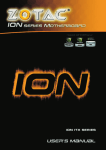
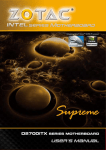
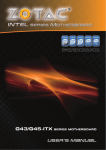
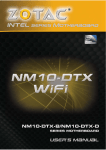

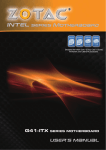
![VadaTech VT85x User Manual[1]](http://vs1.manualzilla.com/store/data/005803212_1-bb50408d9ec4263de47f5dcd2a97e7b3-150x150.png)
